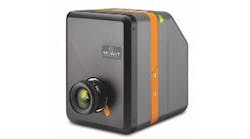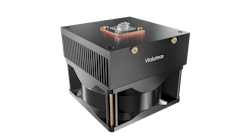Sunnyvale, CA
Compact Osram sensor improves fitness monitoring
First integrated optical sensor introduced by Osram Opto Semiconductors
Osram Opto Semiconductors has developed a new optical sensor for automatic fitness tracking. The SFH 7050 is Osram’s first integrated optical sensor. It is designed for use in mobile devices, such as smart watches and fitness armbands, and it simplifies personal heart rate or pulse rate measurements during jogging, for example. The sensor contains three light emitting diodes with different wavelengths, based on highly efficient chip technology. This helps save power and also offers high signal quality for particularly reliable measurements. A built-in photodetector receives the reflected optical signals and is separated from the emitters by an opaque barrier.
The three emitters built into the sensor have wavelengths of 530 nm (green), 660 nm (red) and 940 nm (infrared). These enable precise measurement of pulse at the wrist or fingertip and the oxygen content of the blood at the fingertip. The emitters can be controlled individually, so the sensor can be used for different applications. Green light has been established as the best option for measuring the pulse at the wrist. Red or infrared emitters are generally used for measuring the pulse at the finger and they can also measure the oxygen content of the blood (pulse oximetry).
Minimum tolerances for consistent measurements
Each of the three emitters is based on highly efficient thin-film chip technology with narrow spectral bandwidths of around 30 nm. The red LED has a specified wavelength tolerance of only ±3 nm. “As far as measuring the oxygen content of blood is concerned, the absorption of light by blood depends largely on the wavelength of the light,” explained Sevugan Nagappan, Product Marketing Manager at Osram Opto Semiconductors. “The small tolerances of the red LED mean that precise measurements can be achieved with the new sensor.”
Compact photodiode for small components
The photodiode integrated in the sensor (4.7 mm x 2.5 mm x 0.9 mm) has an active surface of 1.3 mm x 1.3 mm. The diode is very sensitive to light, and its small size enables an extremely compact sensor. Its high linearity and excellent signal-to-noise ratio are the key features.
The infrared LED can also be used in combination with the photodiode as a proximity sensor to start or stop the measurement automatically as soon as the sensor touches or is removed from the skin. The integrated optical barrier prevents crosstalk from the three LEDs to the photodiode and avoids corruption of the optical signal or the entire measurement.
SFH 7050 is one of the innovations that Osram Opto Semiconductors will be presenting at electronica 2014 (hall A3, booth 110) in Munich, Germany, from November 11 to 14, 2014.
Integrated sensor SFH 7050 features three emitters and a photodiode in a compact unit.
Picture: Osram
Personal pulse monitoring with only one component: the SFH 7050 integrated optical sensor.
Picture: Osram
ABOUT OSRAM OPTO SEMICONDUCTORS
OSRAM, Munich, Germany is one of the two leading light manufacturers in the world. Its subsidiary, OSRAM Opto Semiconductors GmbH in Regensburg (Germany), offers its customers solutions based on semiconductor technology for lighting, sensor and visualization applications. Osram Opto Semiconductors has production sites in Regensburg (Germany), Penang (Malaysia) and Wuxi (China). Its headquarters for North America is in Sunnyvale (USA), and for Asia in Hong Kong. Osram Opto Semiconductors also has sales offices throughout the world. For more information go to www.osram-os.com.
Contact:
Technical Information: OSRAM Opto Semiconductors+1-866-993-5211
E-mail:
[email protected]Web site:
www.osram-os.comSubmit new products, case studies/projects, and other press releases at http://www.ledsmagazine.com/content/leds/en/addcontent.html and http://www.ledsmagazine.com/content/leds/en/iif/add.html.




